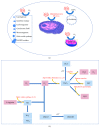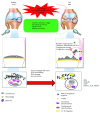Emerging Players at the Intersection of Chondrocyte Loss of Maturational Arrest, Oxidative Stress, Senescence and Low-Grade Inflammation in Osteoarthritis
- PMID: 29599894
- PMCID: PMC5828476
- DOI: 10.1155/2018/3075293
Emerging Players at the Intersection of Chondrocyte Loss of Maturational Arrest, Oxidative Stress, Senescence and Low-Grade Inflammation in Osteoarthritis
Abstract
The prevalence of Osteoarthritis (OA) is increasing because of the progressive aging and unhealthy lifestyle. These risk factors trigger OA by removing constraints that keep the tightly regulated low turnover of the extracellular matrix (ECM) of articular cartilage, the correct chondrocyte phenotype, and the functionality of major homeostatic mechanisms, such as mitophagy, that allows for the clearance of dysfunctional mitochondria, preventing increased production of reactive oxygen species, oxidative stress, and senescence. After OA onset, the presence of ECM degradation products is perceived as a "danger" signal by the chondrocytes and the synovial macrophages that release alarmins with autocrine/paracrine effects on the same cells. Alarmins trigger innate immunity in the joint, with important systemic crosstalks that explain the beneficial effects of dietary interventions and improved lifestyle. Alarmins also boost low-grade inflammation: the release of inflammatory molecules and chemokines sustained by continuous triggering of NF-κB within an altered cellular setting that allows its higher transcriptional activity. Chemokines exert pleiotropic functions in OA, including the recruitment of inflammatory cells and the induction of ECM remodeling. Some chemokines have been successfully targeted to attenuate structural damage or pain in OA animal models. This represents a promising strategy for the future management of human OA.
Figures



Similar articles
-
Aging, articular cartilage chondrocyte senescence and osteoarthritis.Biogerontology. 2002;3(5):257-64. doi: 10.1023/a:1020185404126. Biogerontology. 2002. PMID: 12237562 Review.
-
Potential involvement of oxidative stress in cartilage senescence and development of osteoarthritis: oxidative stress induces chondrocyte telomere instability and downregulation of chondrocyte function.Arthritis Res Ther. 2005;7(2):R380-91. doi: 10.1186/ar1499. Epub 2005 Jan 26. Arthritis Res Ther. 2005. PMID: 15743486 Free PMC article.
-
Paracrine effects of human adipose-derived mesenchymal stem cells in inflammatory stress-induced senescence features of osteoarthritic chondrocytes.Aging (Albany NY). 2016 Aug;8(8):1703-17. doi: 10.18632/aging.101007. Aging (Albany NY). 2016. PMID: 27490266 Free PMC article.
-
Reactive oxygen species and NADPH oxidase 4 involvement in osteoarthritis.Exp Gerontol. 2018 Oct 1;111:107-117. doi: 10.1016/j.exger.2018.07.007. Epub 2018 Jul 17. Exp Gerontol. 2018. PMID: 30012342 Review.
-
Aging and osteoarthritis: Central role of the extracellular matrix.Ageing Res Rev. 2017 Nov;40:20-30. doi: 10.1016/j.arr.2017.07.004. Epub 2017 Jul 31. Ageing Res Rev. 2017. PMID: 28774716 Review.
Cited by
-
Improved function and strength in patients with knee osteoarthritis as a result of adding a two-day educational program to usual care. Prospective randomized trial.Osteoarthr Cartil Open. 2021 Jan 19;3(1):100137. doi: 10.1016/j.ocarto.2020.100137. eCollection 2021 Mar. Osteoarthr Cartil Open. 2021. PMID: 36475075 Free PMC article. Clinical Trial.
-
Absence of cytotoxic and inflammatory effects following in vitro exposure of chondrogenically-differentiated human mesenchymal stem cells to adenosine, lidocaine and Mg2+ solution.J Exp Orthop. 2019 Apr 15;6(1):16. doi: 10.1186/s40634-019-0185-5. J Exp Orthop. 2019. PMID: 30989345 Free PMC article.
-
'QuickDASH' to find unique genes and biological processes associated with shoulder osteoarthritis: a prospective case-control study.BMC Res Notes. 2024 Dec 19;17(1):361. doi: 10.1186/s13104-024-07035-9. BMC Res Notes. 2024. PMID: 39702481 Free PMC article.
-
Chronic intermittent hypobaric hypoxia alleviates early-stage posttraumatic osteoarthritis via NF-κB/Nrf2 pathway in mice.J Orthop Surg Res. 2024 Dec 26;19(1):878. doi: 10.1186/s13018-024-05376-6. J Orthop Surg Res. 2024. PMID: 39726016 Free PMC article.
-
Piezo1 promotes intervertebral disc degeneration through the Ca2+/F-actin/Yap signaling axis.Mol Med. 2025 Mar 8;31(1):90. doi: 10.1186/s10020-025-01147-z. Mol Med. 2025. PMID: 40057686 Free PMC article.
References
Publication types
MeSH terms
LinkOut - more resources
Full Text Sources
Other Literature Sources
Medical

